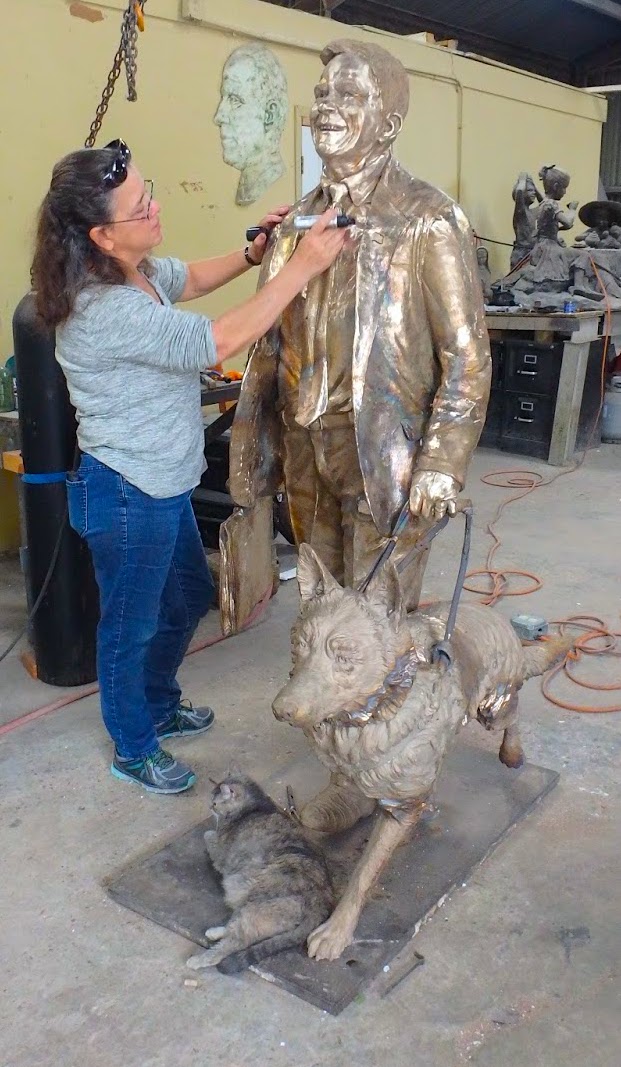The Lost Wax Method of Bronze Casting or Investment Casting
Now that Bridgette has made the mold, she will use that to get a replica of the original art, but instead of being in clay, the foundry will make it in wax. The foundry of Miguel Macias is working on this project. Bridgette has a few different foundries around the country that she uses.
When you see bronze in the park or a museum it is not solid, it is hollow. The foundry does this by making a layer of wax. Our bronze will be as thick as the wax that we are about to create. Let's follow along.


The Wax Positive
It is necessary to have a hollow wax positive model of the original sculpture made. The foundry will use this wax positive to create the final ceramic mold into in which they will pour the the molten bronze alloy.
The foundry creates the hollow wax positive by pouring or painting successive layers of hot wax into the rubber mold. The wax positive will be the same thickness as the final bronze, so careful consideration is taken when creating the wax positive. Often the artist has the rights to cast more than one sculpture. This is referred to as a limited edition. Each edition of a bronze sculpture must have its own wax positive. So an edition of ten will have ten waxes.
Wax Chasing
After the foundry removes the wax positive from the mold they clean it or it is "chased" by the foundry's wax artist, who pays close attention to details. Using numerous tools, some that are hot, they take out the seams and imperfections caused by pouring or painting the wax. Some imperfections can also be made, accidentally during the mold making process. All the details are worked in the wax. Ms. Mongeon also likes to work on the waxes. She will often spend many additional hours, adding intricate detail to them. After the artist signs the wax positive and it is numbered, it is ready for “gating.”


Gating the Wax Positive
The foundry's artisans must pay close attention to how they will pour the bronze alloy and how trapped gases will escape. The wax is "sprued" with wax "gates" [tubes] that form a system of channels that allow the molten bronze to flow evenly. They also add degassing vents and a pouring cup. This is a crucial step because it will determine the quality of the bronze cast.
(The photos shown here are from the Alice Sculpture as the artist was not at the foundry when they were dipping John Turner. Deep in the Heart Art Foundry poured Alice.) You can see the sprues, pour cups and gates on the cups from Alice's table.

The Slurry or Dip
The wax positive, sprued with gates and a pouring cup, is now dipped into a ceramic slurry. The slurry builds a hard ceramic shell made of silica and sand. It covers both the inside and the outside of the wax positive. The gated wax positive is dipped several times into the slurry and then into a bath of sand and must dry completely before each dip.

Wax Burn Out
The foundry places the ceramic shell (with the wax positive still inside) in a hot furnace. The temperature is approximately 2000°F. They burn out the wax and it is lost. This is why people often refer to this process as the lost wax method of bronze casting. Left behind is the ceramic shell. Later, molten bronze alloy is poured into this cavity.
Let's move on to the exciting part of pouring a bronze.
(Images shown are at Deep in The Heart Art Foundry, and the sculpting of Eve. They are not of John Turner. The equipment may be a bit different but the process is the same.)


Check Out the Next Steps in the Process
Bridgette would love to talk to you about your project.








